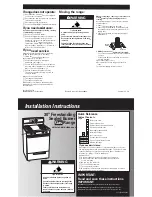
9
Control Lock
The Control Lock shuts down the control panel pads to prevent
unintended use of the oven.
When the control is locked, only the CLOCK and TIMER pads will
function.
To Lock/Unlock Control: Before locking, make sure the oven
and Timer are off. Touch and hold START/ENTER for 5 seconds.
A single tone will sound, “LOC” and “LOCK’D” (on some models)
will appear on the display. “LOC” will also appear whenever any
command pad is pressed while the control is locked.
Repeat to unlock. “LOC” and “LOCK’D” (on some models) will
disappear from the display.
Oven Temperature Control
IMPORTANT: Do not use a thermometer to measure oven
temperature because opening the oven door and element or
burner cycling may give incorrect readings.
The oven provides accurate temperatures; however, it may cook
faster or slower than your previous oven, so the temperature
calibration can be adjusted. It can be changed in Fahrenheit or
Celsius.
A minus sign means the oven will be cooler by the displayed
amount. No sign means the oven will be warmer by the displayed
amount. Use the following chart as a guide.
To Adjust Oven Temperature Calibration:
1. Touch and hold BAKE for 5 seconds until the oven display
shows the current calibration, for example “0.”
2. Touch the TEMP “up” or “down” arrow pad(s) to increase or
to decrease the temperature in 10°F (5°C) amounts. The
adjustment can be set between 30°F (15°C) and -30°F
(-15°C).
3. Touch START/ENTER.
OVEN USE
Odors and smoke are normal when the oven is used the first few
times, or when it is heavily soiled.
IMPORTANT: The health of some birds is extremely sensitive to
the fumes given off. Exposure to the fumes may result in death to
certain birds. Always move birds to another closed and well
ventilated room.
Aluminum Foil
IMPORTANT: Do not line the oven bottom with any type of foil,
liners or cookware because permanent damage will occur to the
oven bottom finish.
■
On those models with bottom vents, do not block or cover
the oven bottom vents.
■
Do not cover entire rack with foil because air must be able to
move freely for best cooking results.
■
To catch spills, place foil on rack below dish. Make sure foil is
at least 1" (2.5 cm) larger than the dish and that it is turned up
at the edges.
Positioning Racks and Bakeware
IMPORTANT: Do not place food or bakeware directly on the oven
door or bottom. Permanent damage will occur to the porcelain
finish.
RACKS
Position racks before turning the oven on. Do not move racks
with bakeware on them. Make sure racks are level. For best
performance, cook on one rack. Place the rack so the top of food
will be centered in the oven. To move a rack, pull it out to the stop
position, raise the front edge, then lift out.
BAKEWARE
To cook food evenly, hot air must be able to circulate. Allow
2" (5 cm) of space around bakeware and oven walls. Use the
following chart as a guide.
ADJUSTMENT °F
(ADJUSTMENT °C)
COOKS FOOD
10°F (5°C)
...a little more
20°F (10°C)
...moderately more
30°F (15°C)
...much more
-10°F (-5°C)
...a little less
-20°F (-10°C)
...moderately less
-30°F (-15°C)
...much less
FOOD
RACK POSITION
Frozen pies, large roasts, turkeys,
angel food cakes
1 or 2
Bundt cakes, most quick breads, yeast
breads, casseroles, meats
2
Cookies, biscuits, muffins, cakes,
nonfrozen pies
2 or 3
NUMBER OF
PAN(S)
POSITION ON RACK
1
Center of rack.
2
Side by side or slightly staggered.
3 or 4
Opposite corners on each rack. Make sure
that no bakeware piece is directly over
another.
Содержание SF315PEPB3
Страница 17: ...17 Notes ...










































